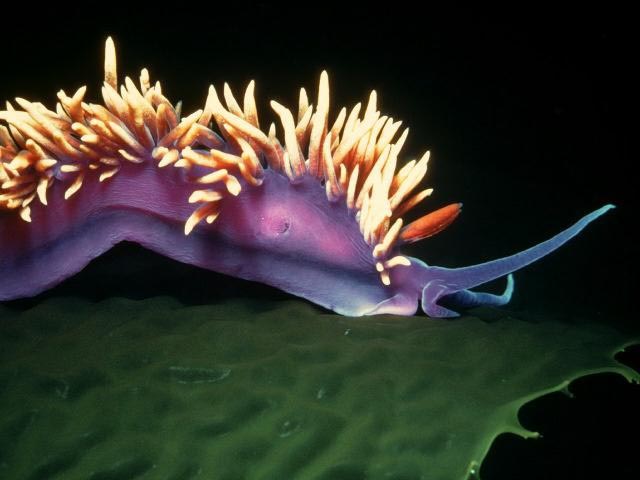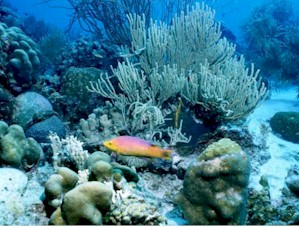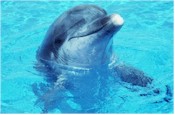Eco-Pros
Environmental Education on
the Web
OCEAN HOME
|
|
Planet Earth is a water planet. Earth's ocean is one great connected body of water that covers more than 70% of the planet's surface and contains 97% of all water on the Earth. Most of the rest of the water is frozen in glaciers and icecaps, and the remainder is in the atmosphere, underground, and in streams, rivers and lakes. We could not live without water. Every natural element can be found in the ocean. Approximately 3˝% of ocean water is made up of salts, most of which is the same as our ordinary table salt. The salts come from the wearing away of rocks, from underwater springs and from material that explodes from volcanoes and falls from the atmosphere. As water evaporates from the ocean, salts are left. Then precipitation (rain) returns fresh water to the ocean. At the equator there is a greater amount of fresh rainwater than there is evaporation from the ocean; therefore, the ocean water is less salty at the equator. Ocean water is also less salty where fresh water from rivers enters the ocean. The ocean provides foods from plants and animals, energy, transportation, medicine, minerals and natural resources, many products, weather systems, climate, rainfall from ocean evaporation, tidal power, and oxygen. The ocean...is the memory of the global climate system and the key to climate variability (NOAA report on Earth Observation Summit 2004). The ocean and the atmosphere interact upon each other, creating a "weather machine" which affects climates and global weather. Far more heat/energy is stored in the ocean than in the atmosphere. Ocean currents help to balance and distribute this heat/energy around the planet and regulate temperatures. Ocean currents are like giant rivers. They move both horizontally and vertically. Surface circulation is regulated by winds and the rotation of Earth, and deeper circulation (thermohaline circulation) is a function of density differences in water masses. The colder, saltier waters in polar regions are heavier and sink to the bottom, and the warmer waters near the equator are less salty and heavy and gradually flow toward the surface. Thermal energy from solar heat and the ocean currents can be converted to electricity and could be utilized as an important alternate source of energy. Once a water mass sinks below the surface of the ocean, it can no longer interact with the atmosphere. The oxygen contained in the water mass very slowly dissolves or is used in the oxidization of dead organic matter. Oceanographers can estimate the length of time the water mass has been away from the surface by analyzing the oxygen content. Through the process, the "oldest" water found has been in the deep North Pacific region, estimated to be 1,500 years old! There is incredible biodiversity of life in the ocean; in fact, more plant and animal life is found in the ocean than on land. Nearly half the Earth's major animal groups live only in the sea. Marine plants and plantlike organisms are found where sunlight can penetrate the water for photosynthesis to occur, so they are nearer the surface. There are great underwater forests of Giant Kelp and vast coral reef ecosystems in the ocean which a tremendous amount of species depend upon for habitat and food sources. Oceans and marine life consume huge amounts of carbon dioxide, and more oxygen is produced and released through oceanic photosynthesis than by all the earth's terrestrial (land) plants and forests combined. As the waters of the ocean are in constant movement, this promotes a whole complex food cycle as various nutrients are carried by currents and cycled through the water. Bits and pieces of organisms and matter rain down through the water as they sink to the bottom. As they move through the water, living organisms and animals consume them. Many nutrients that reach the bottom are consumed by the bottom dwellers. In the deepest depths of the ocean and in trenches, there are many creatures we haven't discovered yet. In certain areas of the ocean, upwelling occurs where the colder, deeper waters full of nutrients are carried upwards. These areas support a great abundance of life. About 13,000 different species of fish live in the ocean. Some marine mammals live their whole lives in the ocean (such as whales and porpoises) and others can spend time in the ocean or on land (such as sea lions and seals). Did you know that the polar bear is considered to be a marine mammal?
Most of the sea animals live in the surface waters where there is an abundance of food. But there are some very unique lifeforms in the deepest parts of the ocean. Sunlight cannot penetrate deep into the ocean, so some of the animals don't have eyes. They have developed other senses to help them find their way around and to enable them to obtain food. Although there is no sunlight in the deep ocean, there is a source of light. It is called bioluminescence and this is caused by chemical reactions within certain organisms. Other unusual life in the deepest parts of the ocean have recently been discovered, existing and flourishing around deep ocean vents which emit heat from within the planet at temperatures we believed would kill all living organisms. Humans have caused great
damage to the oceans ecosystems and inhabitants. Many areas have been
severely polluted, especially from industrial wastes and sewage near
coasts, and oil spills and dumping of wastes in the ocean. Recent
studies have shown that excessive carbon in the atmosphere from the burning of
fossil fuels has dramatically increased the acidity of the Earth's oceans.
This ocean acidification is threatening the oceans' ecosystems, sea creatures
and their food supplies. Also, the continued depletion of the Ozone Layer
in the upper atmosphere could lead to a dramatic decline in the growth of the
world's oceanic Plankton, which is the basis of most marine food chains. In addition, humans
have overfished certain species to the point of endangering the survival of
those species. Harmful fishing methods and mining practices continue
to destroy underwater ecosystems. The living ocean has been the
|




|
WORLD OCEAN DAY IS JUNE 8, 2006 Learn about all the great things that happened in 2005 to help improve the health of the ocean. Download World Ocean Day 2006 materials and resources for this year's celebration from The Ocean Project site. Tell The Ocean Project what plans you have for World Ocean Day. You don't have to live by the ocean to celebrate World Ocean Day. You can participate in activities that relate to the ocean. Suggestions for activities are provided on the site. Get your school and community involved. Click on Ocean Resource Center for links to lots of helps and information. |
|||||||||||||||||||||||||||
| NAMES OF OCEANS AND TRIBUTARY SEAS | |||||||||||||||||||||||||||
|
SAVING OUR LIVING SEAS The ocean is comprised of vast "dynamic biomes that are among the richest and most productive ecosystems on Earth." As we continue to degrade the health of the ocean and marine habitat, we risk extinction of species and destruction of the functions and life-sustaining processes of Earth's natural systems. (Conservation International) |
|||||||||||||||||||||||||||
| SMITHSONIAN'S OCEAN PLANET | |||||||||||||||||||||||||||
|
TEN
THINGS YOU CAN DO TO SAVE THE OCEANS (Ocean
Alliance) The Ocean Alliance is dedicated to the conservation of whales and their ocean environment through research and education. Find out more about whales on our Whales page. |
|||||||||||||||||||||||||||
| OCEAN
LINK
Marine scientists answer questions on marine invertebrates (which have no spinal column; such as jellyfish, worms, shrimp, octopus, etc.) and vertebrates (which have a spinal column; such as fishes, mammals, reptiles and birds). Scientists explain what marine biologists do, and answer questions on marine ecology, oceanography, hydrothermal vents and deep sea animals, biodiversity and marine pollution. |
|||||||||||||||||||||||||||
SUSTAINABLE
SEAS
|
|||||||||||||||||||||||||||
|
SCRIPPS INSTITUTION OF
OCEANOGRAPHY (SIO Explorer Expedition Discoveries) "Only about 10 percent of the ocean floor has been comprehensively mapped using modern sonar. There is still much to discover beneath the world's oceans, which cover 140 million square miles, or 72 percent of the Earth's surface." Experience
expeditions of Scripps' voyages of discovery as they take
sonar readings and create
breathtaking computer images of towering seamounts, deep canyons and wide
plains. "It's a geologist's paradise down
there" |
|||||||||||||||||||||||||||
HUMAN
IMPACT ON OCEANS -
OUR GLOBAL GARBAGE DUMP!
|
|||||||||||||||||||||||||||
| THE
OCEAN CONSERVANCY "We must view the oceans in a new way -- not as an infinite and inexhaustible resource but as a fragile web of life that is being damaged by human activities."
CENTER
FOR MARINE CONSERVATION (renamed The Ocean Conservancy) |
|||||||||||||||||||||||||||
| PEW
OCEANS COMMISSION Ocean Facts: The Diversity of Marine Life, Human Impacts, Economic Contributions, The Stratton Commission, Our Planet's Life Support System |
|||||||||||||||||||||||||||
| COUSTEAU SOCIETY LINKS | |||||||||||||||||||||||||||
|
NATIONAL
MARINE MAMMAL LABORATORY Research programs, education web, ecosystems, online library, resource links, search function. |
|||||||||||||||||||||||||||
| NATIONAL
OCEANIC AND ATMOSPHERIC ADMINISTRATION - U.S. Dept of Commerce "NOAA's Mission is to describe and predict changes in the Earth's environment, and conserve and wisely manage the Nation's coastal and marine resources." |
|||||||||||||||||||||||||||
|
FISHING METHODS
- Marine Conservation Society / FishOnline.org Types described: Beam trawl, Demersal otter trawl, Multi-rig trawl, Dive-caught, Dredging, Drift net, Fish attraction devices, Fish farming, Gill or fixed nets, Handline, Jigging, Trolling, Hand-gathering / picking / collection, Harpoon, Hydraulic dredges, Industrial fishing, Long-lining, Pelagic trawl, Pole and line, Pots / creels, Purse seining, Seine netting, Trap / nets, Use of explosives or poisons. |
|||||||||||||||||||||||||||
| WOODS
HOLE OCEANOGRAPHIC INSTITUTION Take the Voyage to Puna Ridge 3 miles under the sea. Then click on the M and M candy, read about visible light in the ocean, and click on each of the 4 M and M's (red, yellow, green, blue) and see what happens. Learn about light, sound, biology, rocks, volcanic eruptions, latitude/longitude and sonar. Imagine the immense biodiversity of life in the oceans, and all the species that have not been discovered yet. Look at a globe or world map and see how much of our Earth is covered by oceans. Click on subjects in the list in the frame on the left side of the page. DIVE AND DISCOVER - Expeditions to the sea floor |
|||||||||||||||||||||||||||
| THE
PLANKTON NET Plankton Ecology, Marine Biology and Biological Oceanography |
|||||||||||||||||||||||||||
| NAVAL METEOROLOGY AND OCEANOGRAPHY COMMAND - NEPTUNE'S WEB | |||||||||||||||||||||||||||
| SEAWEB Resources (List of links, newsletter, calendar of ocean events) Background (Briefing Book - overviews of issues, Related Background Articles) Campaigns The Ocean Report - Listen to special reports on Radio Voyager Network |
|||||||||||||||||||||||||||
| OCEANLINK - Marine science information. Ask a Marine Scientist has lots of questions already answered for you. In OceanInfo, understanding tides is made easy with some great graphics. Interesting facts can also be found in Records (biggest, smallest, fastest, deepest). | |||||||||||||||||||||||||||
| THE MARINE MAMMAL CENTER - Conservation of marine mammals and ocean habitat. The Marine Mammal Center rescues hundreds of injured, sick and orphaned marine mammals every year along 600 miles of northern and central California coastline. The Center uniquely combines its rehabilitation program with scientific discovery and education programs. | |||||||||||||||||||||||||||
| EXTREME
2000 VOYAGE TO THE DEEP Can you imagine organisms that live in total darkness, thriving on toxic chemicals in super-hot water 235°F, under crushing pressure 250 times the pressure we feel on land? Only in the movies? Read on... Scientists voyage to hydrothermal vents deep in the ocean to study these bizarre ecosystems and discover things which could benefit humanity. Learn why water 750°F does not boil (Seafloor Geology). See the most heat-tolerant animal on Earth (Creature Features). Read about chemosynthesis (Toxic Chemistry). SEAFLOOR
VENTS |
|||||||||||||||||||||||||||
| BIOLUMINESCENCE
WEB PAGE
If you live 5 miles down in the ocean depths there is not much need for eyes, but you need other senses to get around and find food to survive. Some animals in the ocean have specialized organs which produce light through chemical reactions. This light produced from within organisms is called bioluminescence. Certain colors of this light serve various functions. Some colors attract prey, others repel predators and scare them away, and some colors of light cannot be seen by other animals, yet light the way in the blackness of the deep ocean for the bioluminescent animal. Changing the colors of luminescence can serve as camouflage, and certain species can send coded messages to others of their species. Satellites use oceanic luminescence to estimate the amount of biomass (living matter) in various regions of the ocean. (Scroll down the page for information, then click on the subjects on the left side of page, such as Myths and Facts, Photos, and Organisms.) |
|||||||||||||||||||||||||||
| WHAT
IS AN ALGAE BLOOM? The biggest one ever measured was roughly the size of New Jersey! (Ecological Society of America) |
|||||||||||||||||||||||||||
| FORESTS OF GIANT KELP - Dive into our "mini-IMAX" picture | |||||||||||||||||||||||||||
| EXPEDITION GALLERY - Photos and video clips (watch an octopus scamper) | |||||||||||||||||||||||||||
| FLORIDA
FISH AND WILDLIFE CONSERVATION COMMISSION Click on Questions at top for information on frequently asked questions. Links below provide information on coral, fish, invertebrates, marine mammals, red tide, seagrasses, and sea turtles. |
|||||||||||||||||||||||||||
| OUR UNDERSEA YELLOWSTONES - Should Wilderness Protection Stop at Land's End? | |||||||||||||||||||||||||||
|
SCRIPPS INSTITUTION
OF OCEANOGRAPHY Directory of valuable career information links to careers in Oceanography, Marine Science & Marine Biology |
|||||||||||||||||||||||||||
| SEAMOUNTS
- Conical shaped
mountains under the sea, known as hotspots. The Hawaiian Islands
were formed from a hotspot. Learn more about them and the strange
diversity of sealife found around ancient extinct volcanos. ENN - Mountains of the Underworld (8/31/00) Tasmanian Seamounts Marine Reserve |
|||||||||||||||||||||||||||
|
SEAWEB
- Advancing ocean protection and conservation.
|
|||||||||||||||||||||||||||
| CLEANUPS
- Let us know about your group efforts to clean our water sources YOU CAN HELP MAKE A DIFFERENCE! Remember: Always use caution and good sense when around water.
|
|||||||||||||||||||||||||||
| OIL
SPILLS AND WILDLIFE REHABILITATION Links provided by University of California (UC Davis) |
|||||||||||||||||||||||||||
| AMERICA'S
COASTLINE ALBUM NOAA invites you to "view the waves and flying spray, rocky shores and sandy beaches, marshes and mangroves, seaside villages and great port cities" of America's coastlines. (Click on the various geographical areas in right frame and then on pages in collections. For larger pictures of small images, click on the small images.) |
|||||||||||||||||||||||||||
| SURFLINE - Gettin' wet on the net. Surf reports, forecasts and live cams around the world. | |||||||||||||||||||||||||||
| SEAFOOD
GUIDE - Fish Choices from Environmental Defense
(EDF) Lists of fish that generally come from environmentally sound sources, and fish that you should avoid purchasing. SEAFOOD GUIDE - California Academy of Sciences suggests ways you can help conserve the ocean's resources through sensible seafood choices. Includes lots of facts about harmful fishing, overfishing, fishstock depletion, industry practices, fish to avoid, and fish you should choose.
|
|||||||||||||||||||||||||||
|
WHALES
PAGE |
|||||||||||||||||||||||||||
|
What are some differences between dolphins and porpoises?
Whales, dolphins and porpoises are in the same scientific group, Cetacea.
|
|||||||||||||||||||||||||||
|
Get on the Big Blue Bus and take
a trip to Canadian Waters to visit with Neptune, Puffy the Pollution Slayer,
Billy the Bass, Maximus Octopus, Dolly Varden, William Whitefish, Judge
Jellyfish, and other creatures. Lots of stories, facts, quiz
questions, and activities as you explore the watery world. (Dept of
Fisheries and Oceans, Canada) |
|||||||||||||||||||||||||||
|
Return to |




